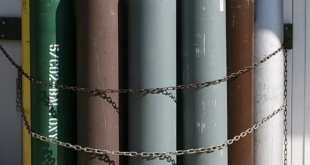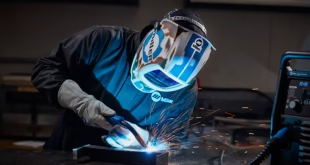Welding Stainless to Carbon Steel
Welding stainless steels to carbon (mild) steels is one of the most practical — yet metallurgically tricky — tasks a welder faces. The join is common in piping, heat exchangers, exhaust systems, and many retrofit repairs where corrosion resistance is needed only on one side of an assembly. Done well, the joint combines the best of both materials: the corrosion resistance of stainless and the economy / strength of carbon steel. Done poorly, the weld will corrode, crack, or fail prematurely.
Metallurgical Differences and Why They Matter
Stainless steel families — a quick primer
Stainless steels are a family: austenitic (304, 316), ferritic (409, 430), martensitic (410), and duplex types. Austenitics (304/316) are the most common for corrosion resistance and are generally easy to weld. Ferritic and martensitic grades behave differently — they are more prone to grain growth, magnetic, and can embrittle. Choosing how to join a carbon steel to stainless starts with identifying which stainless family you have.
Carbon / mild steel basics
Carbon or mild steel (low-alloy steels) contains little or no nickel and low chromium. It is cheaper, weldable, and often used where corrosion resistance is not a critical factor. Carbon content and alloying levels determine whether preheat or PWHT are required.
Critical mismatches: chemistry, thermal expansion and nobility
There are three practical mismatches to keep foremost in mind:
Chemistry — Stainless relies on chromium (and often nickel and molybdenum) for corrosion resistance. Dilution of stainless by iron and carbon from the carbon steel reduces the corrosion resistance near the weld.
Coefficient of thermal expansion (CTE) — Austenitic stainless expands more with heat than carbon steel. Differential expansion causes residual stresses and can aid cracking or distortion.
Electrochemical potential — Stainless is more ‘noble’ than carbon steel, which sets up galvanic corrosion when both are in contact in an electrolyte (water, moisture). That means the carbon steel will often corrode preferentially unless the design isolates it.
Primary Challenges When Joining Stainless to Carbon
Carbon migration and sensitization
When carbon from the mild steel diffuses into the stainless near the fusion line, it can combine with chromium to form chromium carbides. This depletes chromium in grain boundaries and can cause sensitization — a loss of corrosion resistance and susceptibility to intergranular corrosion. Using low-carbon stainless (L grades) or nickel-based fillers and minimizing high-temperature dwell times helps reduce this.
Galvanic corrosion
Because stainless is cathodic relative to carbon steel, any electrolytic path will accelerate corrosion of the carbon side. Design to avoid exposed dissimilar couples or insulate/coat the carbon surface to slow the problem.
Residual stresses and differential expansion
Higher CTE and larger weld metal zones cause thermal strains. Repeated heating/cooling cycles create tensile stresses in the weld area that, with brittle microstructures, can initiate cracks.
Cracking and microstructural risks
Several forms of cracking can occur: hot cracking (solidification cracks) in austenitic weld metal if composition and welding practice are wrong; hydrogen-assisted cracking in the carbon side if moisture/contamination exists; and brittle HAZs if PWHT or filler selection is inappropriate.
Filler Metal Options and Selection Strategy
ER309 / ER309L stainless fillers — the common choice
For most stainless-to-carbon combinations, ER309L (or AWS SFA designation equivalents) is the go-to filler. ER309L has higher chromium and nickel content than base stainless such that, when mixed with iron from the carbon steel by dilution, the resulting weld metal still retains an austenitic, corrosion-resistant character. The low-carbon “L” limits carbide precipitation.
When to use: butt joints, lap joints, and most process piping joins where cost and corrosion resistance are moderate.
When base stainless is 316 or contains molybdenum
If the stainless base metal is 316 (molybdenum alloyed) and service demands higher corrosion resistance, 309L still remains a practical transition filler. For extremely corrosive environments, consider higher-alloy or nickel-based fillers to retain required properties.
Nickel-based fillers (Inconel / ENi alloys)
Nickel alloys (e.g., Inconel 82/182 family and other ENi fillers) are more tolerant of dilution and carbon migration, they do not rely on chromium carbide chemistry and they can reduce cracking and sensitization risks. They’re widely used in critical service or when the joint must sustain PWHT or aggressive corrosion service. The downside is cost and sometimes different mechanical behavior.
When to use: critical petroleum/chemical service, high temperature service, and when PWHT is necessary on the carbon side.
Field electrodes and flux-cored choices
For stick welding (SMAW), use E309-type electrodes for joining stainless to carbon. For flux-cored and self-shielding wires, choose wires specifically formulated for dissimilar metal work; many manufacturers supply 309-type flux-cored wires. Always match the filler to the process and service needs.
Techniques to Make a Reliable Transition
Buttering/buildup layers
Buttering means depositing a layer (or layers) of stainless or nickel filler onto the carbon steel first. This creates a buffer so the final stainless-to-stainless weld (stainless to butter) is done with much less dilution by carbon steel. Benefits: reduces carbon migration, simplifies the final welding metallurgy, and lowers the chance of sensitization. Buttering must be welded with controlled technique and qualified as part of the WPS.
Transition layers vs direct weld
A direct weld (stainless filler across both base metals) is simpler but allows more dilution. Transition layers (buttering) are safer for critical service. Choose based on code requirements, accessibility, and economics.
Welding sequence and distortion control
Use balanced welding sequences, limit heat input, prefer stringer beads over wide weaves, and tack strategically. These practices control distortion and limit the thermal exposure that encourages sensitization.
Process Selection: TIG, MIG, Stick, FCAW, SAW
GTAW / TIG — precision and composition control
TIG gives the best control over weld metal composition and heat input. Use TIG for final root passes, thin sections, and where appearance and corrosion resistance matter most.
GMAW / MIG — productivity with correct wire
MIG with ER309L wire is common for productivity. Careful shielding gas selection and correct parameters control dilution and porosity. MIG is often used for filler passes after TIG root.
SMAW / Stick and FCAW — field workhorse
For site repairs or heavy structural work, stick electrodes 309/309L are widely used. FCAW flux-cored wires formulated to 309 composition give faster deposition in field settings.
Multi-process approaches
A typical practical approach: TIG root to ensure controlled fusion, then MIG or FCAW fill passes. This combines best quality and productivity.
Preheat, Interpass Temperature, and PWHT Considerations
Preheat on the carbon side — why and how
Preheat is used on carbon steel to reduce cooling rate, avoiding hard, brittle martensite in the HAZ and reducing risk of hydrogen-assisted cracking. The required preheat depends on carbon equivalent and thickness. Principle: preheat the carbon side as necessary, but avoid excessive temperature that exposes stainless to long dwell at sensitization temperatures.
Interpass temperature control
Keep interpass temperatures controlled and avoid long dwell in the 450–850°C window where chromium carbides form easily. Low-carbon stainless (L grades) helps, as does limiting interpass temperature and using quick passes with lower heat input.
PWHT trade-offs
Post-weld heat treatment is sometimes mandatory for carbon steel components; however, PWHT can sensitize stainless or change its corrosion behavior. If PWHT is required, plan the procedure carefully — either restrict PWHT to localized zones when allowed, or use nickel-based filler metals that tolerate PWHT better. Always qualify PWHT in the procedure record (PQR).
Joint Design, Fit-up and Preparation
Edge preparation and bevel geometry
Design joints to control dilution and allow good penetration without excessive heat. For pipe, a standard bevel with controlled root gap works well; for plate, small root faces and controlled gaps reduce the volume of weld metal and help control heat input.
Cleaning and contamination control
Remove oil, paint, and rust. Use dedicated stainless steel brushes and grinding discs for stainless surfaces to avoid ferric contamination. Cross-contamination is a leading cause of corrosion problems.
Back-purging and shielding
For stainless surfaces, back-purge with argon during TIG or MIG root passes to avoid oxidation and preserve corrosion resistance. On pipe roots, good purging yields a clean root bead with minimal darkening.
Inspection, Testing and Qualification
NDT and mechanical tests
Visual inspection, dye-penetrant testing (for surface cracks), radiography (for internal defects), and MPI (for ferromagnetic portions) are standard. For critical service, perform tensile, bend, and impact testing as dictated by codes.
Hardness mapping and macro examination
A hardness traverse across the weld and HAZ can reveal brittle regions on the carbon side. Macro-etching helps reveal dilution zones and butt fusion quality.
WPS / PQR and code compliance
Follow applicable codes (ASME Section IX, AWS D1.1 where applicable) and always qualify your welding procedure for dissimilar metal joints. Procedure qualification has to represent the actual filler, base metals, thicknesses, and any PWHT used.
Common Problems and Troubleshooting
Porosity and lack of fusion
Porosity commonly results from contamination or poor shielding gas. Solution: clean parts, ensure correct gas flow, use proper travel angle and parameters. Lack of fusion often stems from improper heat input or poor fit-up — increase heat or adjust bead placement.
Cracking at the toe or HAZ
Cracking may result from high residual tensile stress, hydrogen embrittlement, or unsuitable filler. Remedies include correct preheat, use of low-hydrogen electrodes, limiting heat input, and choosing nickel fillers in severe cases.
Post-installation corrosion problems
If carbon steel near the joint begins to corrode, look for galvanic coupling, inadequate coating, or joint crevices. Remedies include isolating the dissimilar metals, painting or coating the carbon side, or installing sacrificial anodes where applicable.
Practical Examples and Best-Practice Checklist
Typical pipe weld example (process piping)
A common approach for a 304 stainless to carbon steel pipe butt joint in a chemical plant:
Inspect metals, identify grade.
Clean both surfaces, use stainless brush on the stainless pipe.
Butter the carbon side with ER309L or nickel filler (if service-critical). Allow each butter pass to cool; finish profile.
Weld stainless to butter layer using ER309L (TIG root for best control, MIG fill).
Back-purge stainless side during root passes.
Inspect visually and by NDT as required; hardness check if necessary.
Buttering procedure — step by step
Prepare carbon surface (grind to bright metal).
Preheat per carbon steel needs.
Deposit 2–3 butter passes of stainless or Ni filler, controlling heat and bead profile.
Let layer cool, then blend and prepare for final weld.
Weld stainless to butter as if welding stainless-to-stainless.
Quick pre-weld checklist
Confirm base metal grades and thicknesses.
Select filler (ER309L for general service; nickel for critical / PWHT).
Clean with dedicated tools.
Decide process sequence (TIG root, MIG fill recommended).
Set preheat for carbon side if needed.
Plan purge for stainless side.
Prepare WPS and record parameters for PQR.
FAQs
What filler metal should I pick for welding 304 stainless to A36 carbon steel?
ER309L stainless filler is the most common, cost-effective choice.
When should I use a nickel-based filler instead of ER309L?
Use nickel-based filler when the joint must tolerate PWHT, resist aggressive corrosion, or where minimizing carbon migration is essential.
Is preheat always necessary when welding stainless to carbon steel?
Not always — preheat depends on the carbon steel’s thickness and chemistry (carbon equivalent); it’s applied primarily to the carbon side to reduce the risk of hydrogen-induced cracking.
What is buttering and why is it useful for stainless-to-carbon welds?
Buttering is depositing a buffer layer of stainless or nickel filler on the carbon steel before making the final joint.
How do I prevent galvanic corrosion where stainless meets carbon steel?
Electrically isolate or coat the carbon steel, avoid crevices, or use sacrificial protection if separation isn’t possible.
Conclusion
Joining stainless steel to carbon steel is a practical necessity in many industries, but it requires deliberate metallurgy-aware choices. The three pillars of a good dissimilar-metal weld are: correct filler selection (ER309L or nickel where needed), process control (root technique, heat input and purging), and preparation (cleaning, buttering when required, and qualified procedures). When you follow these principles — combined with proper inspection and adherence to codes — you can produce joints that deliver service life, safety, and acceptable economics. Think of the joint as a small, carefully managed ecosystem: control what enters it (contaminants and carbon), control its environment (heat and shielding), and use the right inhabitants (filler metals) to keep things healthy.
 Welding of Welders All about Welding and Welders
Welding of Welders All about Welding and Welders




